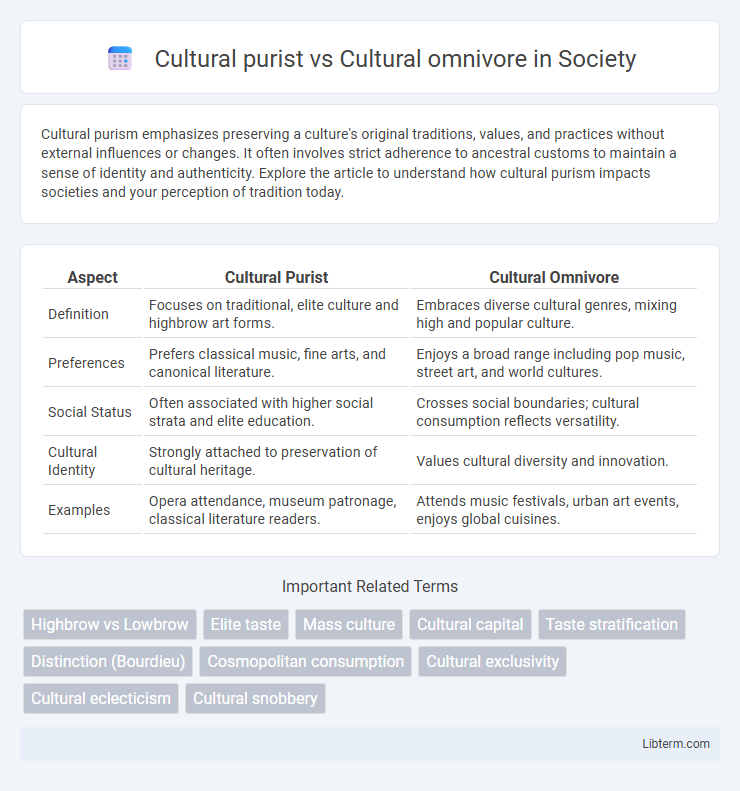Cultural purism emphasizes preserving a culture's original traditions, values, and practices without external influences or changes. It often involves strict adherence to ancestral customs to maintain a sense of identity and authenticity. Explore the article to understand how cultural purism impacts societies and your perception of tradition today.
Table of Comparison
| Aspect | Cultural Purist | Cultural Omnivore |
|---|---|---|
| Definition | Focuses on traditional, elite culture and highbrow art forms. | Embraces diverse cultural genres, mixing high and popular culture. |
| Preferences | Prefers classical music, fine arts, and canonical literature. | Enjoys a broad range including pop music, street art, and world cultures. |
| Social Status | Often associated with higher social strata and elite education. | Crosses social boundaries; cultural consumption reflects versatility. |
| Cultural Identity | Strongly attached to preservation of cultural heritage. | Values cultural diversity and innovation. |
| Examples | Opera attendance, museum patronage, classical literature readers. | Attends music festivals, urban art events, enjoys global cuisines. |
Defining Cultural Purists and Cultural Omnivores
Cultural purists adhere strictly to traditional or highbrow cultural forms, valuing classical music, fine arts, and canonical literature as markers of refined taste. Cultural omnivores embrace a diverse array of cultural expressions, ranging from high culture to popular and niche genres, reflecting eclectic preferences and inclusive attitudes. This distinction highlights contrasting approaches to cultural consumption, where purists prioritize exclusivity and omnivores emphasize range and versatility.
Historical Roots of Cultural Consumption
The historical roots of cultural consumption reveal a divide between cultural purists, who historically favored exclusive, highbrow forms of art linked to elite social classes, and cultural omnivores, who embrace diverse genres spanning both traditional high culture and popular culture. Early sociological studies, such as those by Pierre Bourdieu, emphasized how taste functioned as a marker of social distinction, with purists maintaining rigid boundaries around legitimate culture. In contrast, emerging patterns in late 20th-century societies show omnivores adopting eclectic cultural consumption habits, reflecting increased social mobility and broader access to varied cultural experiences.
Key Traits of Cultural Purists
Cultural purists prioritize traditional, highbrow art forms such as classical music, fine art, and literature, often valuing cultural heritage and authenticity over popular or contemporary expressions. They tend to reject mainstream or mass culture, emphasizing exclusivity and a deep appreciation for established cultural standards. This group often exhibits selective consumption patterns, preferring activities and tastes that align with elite cultural norms and demonstrate refined cultural capital.
Characteristics of Cultural Omnivores
Cultural omnivores exhibit diverse cultural tastes that span highbrow and popular art forms, engaging with a wide range of music, literature, food, and entertainment genres. This group emphasizes inclusivity and eclecticism, often blending traditional elite preferences with contemporary mainstream culture, reflecting open-mindedness and adaptability. Their consumption patterns reveal a preference for experimentation and cultural exploration, contrasting with the narrow, exclusive tastes typical of cultural purists.
Societal Influences on Cultural Preferences
Societal influences significantly shape cultural preferences by reinforcing identity and social status through selective cultural consumption. Cultural purists often adhere to traditional, elite cultural forms as a means of maintaining social boundaries, while cultural omnivores demonstrate inclusive consumption patterns that cut across diverse genres and social groups. These patterns reflect broader societal dynamics, including globalization, education levels, and social mobility, which influence the adoption and valorization of cultural tastes.
The Role of Globalization in Cultural Diversity
Globalization has expanded access to diverse cultural expressions, fueling the rise of cultural omnivores who engage with a wide range of global art, music, and cuisine beyond traditional boundaries. Cultural purists, however, may resist this influx, emphasizing preservation of native customs and identities amid global homogenization. The dynamic interplay between cultural purism and omnivorous tendencies shapes evolving patterns of cultural diversity in a connected world.
Cultural Purism: Preservation or Exclusion?
Cultural purism emphasizes the preservation of traditional cultural practices, valuing authenticity and continuity within a defined group. This approach often prioritizes safeguarding heritage against external influences, which can lead to exclusionary attitudes toward cultural diversity. The tension between maintaining cultural identity and adapting to evolving societal norms highlights the complex dynamics of cultural purism in contemporary multicultural contexts.
Cultural Omnivorousness: Inclusivity or Superficiality?
Cultural omnivorousness refers to the consumption of a wide variety of cultural forms across traditional high and lowbrow boundaries, signifying inclusivity by embracing diverse tastes and social groups. Critics argue this broad engagement can be superficial, lacking deep appreciation or understanding, and motivated by status signaling rather than genuine interest. The debate centers on whether cultural omnivorousness fosters social inclusion or perpetuates shallow consumption patterns disconnected from authentic cultural meaning.
Impact on Arts, Media, and Social Identity
Cultural purists emphasize traditional art forms and media that preserve established social identities, often resisting global influences to maintain cultural authenticity. Cultural omnivores engage with a diverse range of artistic expressions, blending high and popular culture in media consumption, which fosters inclusive social identities and promotes cultural hybridity. This dynamic shapes contemporary arts by balancing preservation with innovation, influencing how communities perceive themselves and their place in a globalized world.
The Future of Culture: Purism, Omnivorousness, or Hybridization?
The future of culture increasingly leans toward hybridization, blending elements of cultural purism and omnivorousness to create more inclusive and diverse cultural expressions. Cultural purists prioritize preserving traditional forms and values, while cultural omnivores embrace a wide range of styles and influences across social and ethnic boundaries. Emerging trends suggest a dynamic interplay where hybrid cultural identities foster innovation and adaptability in globalized societies.
Cultural purist Infographic

 libterm.com
libterm.com